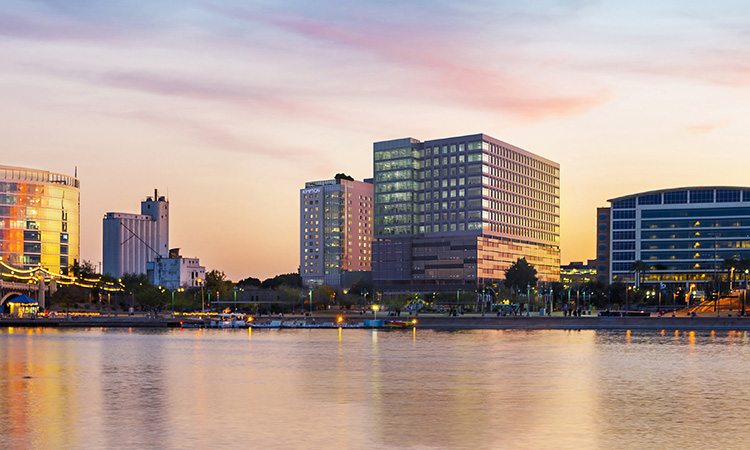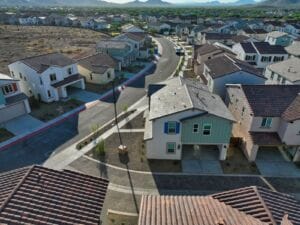An attractive market for real estate investment and development can start and end with the economy.
Hence, the woes felt during the Great Recession when the economy was down, unemployment was up and real estate activity was dramatically affected, but fast-forward to now. The stock market recently hit an all-time high, spending is up, unemployment is down and some experts are hopeful President Donald Trump’s proposed tax plan will give the economy another boost.
While many in the real estate industry remain cautiously optimistic about 2018, others are starting to think this expansion cycle is getting long in the tooth and starting to show signs for slowing. 
Overall, the industry is optimistic for 1-2 more years of favorable conditions before the Arizona market reaches the ninth inning, barring any major macro-economic disruptions.
To better explain how it all breaks down in 2018, experts from their respective sectors peered into their crystal balls to provide this annual outlook. In addition, 40 companies were identified as worth watching this year based on what each accomplished the year before as well as projects and projections for the year ahead.
Housing: Multifamily & Single-family
In 2017, rising home prices, mortgage accessibility, economic growth and more multifamily developments helped improve housing affordability and access, but the disparity between housing needs and housing supply will remain a concern in 2018.
On the multifamily side, 2017 concluded with more than 17,000-units under construction in Greater Phoenix and over 11,000 more units planned for 2018 across 56 properties.
Jim Pierson, senior vice president of Walker & Dunlop, says, people are for the most part still bullish on multifamily but new developments going forward will need to moderate on build-outs, amenities and price per square-foot. “The biggest issue is getting the deals financed,” he adds.
In terms of multifamily sales, Thomas Brophy, research director at ABI Multifamily, says, “Large institutional players are all back in the Valley looking for buys and, in my eyes, is a harbinger of what 2018 will be like.”
He predicts Downtown Phoenix and Tempe will continue to be the hottest multifamily submarkets, but also foresees more boutique, garden-style apartment communities gaining traction in submarkets just outside of the urban cores like Queen Creek and Northwest Phoenix.
As for single-family homes, Craig Krumwiede, president and CEO of Harvard Investments, says, despite some labor and land issues, the housing market feels good and all the indicators are up year-over-year from 2016.
Lending has loosened, more permits and entitlements are being approved and a new single-family rental trend is catching the attention of the developers.
Krumwiede says, over 20 single-family rental projects are already being planned for the West Valley, which closed on 10-12-acre infill sites and are attracting capital.
“This is going to happen and it’s going to affect garden-style apartments that would otherwise go up in those more suburban areas,” he explains. “How it affects the single-family for sale market, I don’t know.”
Meanwhile, more traditional for rent single-family communities, or detached condo-type communities, are being built in Verrado and Eastmark, which rank as two of the top-selling masterplan communities in the country.
Krumwiede predicts this trend to grow in popularity because it can be built for less per square-foot than apartments.
Also, keep an eye on the 20,000-acres of land bought by a Bill Gates owned real estate firm for $80 million in the far West Valley, which may eventually include a portion of the planned Interstate 11 highway and master-planned community with as many as 80,000 homes.
Industrial
As 2017 was coming to a close, Arizona’s industrial market absorption rate was on pace to reach an all-time annual high of 7.9-million square feet, which was previously set in 2005.
As of Q3, the Phoenix industrial market recorded more than 6.1 million square feet of positive net absorption, making 2017 the fourth consecutive year of at least 6.0 million square feet of space absorbed, according to JLL’s Q3 industrial report.

JLL Managing Director Pat Harlan credits the momentum to well-rounded market activity from sectors that include, but are not limited to, manufacturing, high-tech aerospace, e-commerce, food packaging, nutraceuticals and logistics and distribution.
While development activity has been strong throughout the Valley, almost all of the speculative development available is tailored to warehouse and distribution operations. Most notably, Niagra Bottling, Cardinal Glass and Turbo Resources have a combined 700,000 square feet of custom manufacturing space under construction.
Looking ahead, expect to see construction for build-to-suits become more common amongst manufacturing users as a result of manufacturing rates escalating in existing properties and no speculative manufacturing buildings under development.
Overall, the Phoenix industrial market is showing no signs of slowing down, with another 4.4-million square feet under construction as of Q4 2017 to meet strong tenant demand.
Despite the Inland Empire market of California continuing to lead the nation in positive absorption, the strength of that market and cost advantages of Arizona will make Phoenix appealing to new industrial tenants in 2018 and beyond.
Will Strong, executive manageing director at Cushman and Wakefield describes the Phoenix industrial market as “exceptionally competative.”
“This is thanks largely in part to our affordable housing, abundant labor pool and avilability of quality developments and sites to accomadate,” explains Strong. “Also, Phoenix has been agrressive on tax credits and incentives, which resulted in our reputation for being a pro-business climate.”
In addition to Phoenix’s skilled workforce, avilable sites and business climate, Strong notes that the Pheonix market is able to service nearly 40 million customers within a one-day truck haul, which has already spurred some major companies to take advantage such as Amazon, Huhtamaki North America, Lucid Motors and more.
Office
Heading into 2018, Arizona is nationally ranked as the best state for business, number one for job growth and one of the fastest-growing states in the country, according to the Arizona Commerce Authority.

Those indicators bode well for the state’s office market outlook, especially for Metro Phoenix, which saw double-digit tech sector growth within the local office market. According to CBRE’s annual Tech-30 report, Phoenix’s high-tech employment grew 25.4 percent over 2015 and 2016, with average office asking rents rising 13.4 percent to $25.01 from Q2 2015 to Q2 2017.
“Overall, Metro Phoenix’s office market is performing well, with tech being a major driver,” says Bryan Taute, executive vice president at CBRE. “Downtown Phoenix and Scottsdale continue to garner attention from tech companies, but Tempe tops the charts in terms of tech rent growth. All of these areas have seen significant demand from tech companies looking to draw from a high concentration of Millennials.”
Looking ahead, Stanton Shafer, chief operation officer at Holualoa Companies, predicts upward pressure on rents for office projects that offer the right space in the right location over the next two years.
As tenants become pickier about what they lease and where, Shafer foresees a drop in speculative developments as renovations are becoming an increasingly popular way to modernize a property with open, collaborative spaces and new on-site amenities to attract creative office users and secure higher rents. 
Expect to see continued positive absorption and demand in primary markets like Downtown Phoenix, Scottsdale and Tempe, but less in other submarkets.
Due to rising rent rates and occupancy, keep an eye on demand for modern office space in Downtown Phoenix, which may spill over into Midtown where numerous renovations have recently been completed or currently underway to attract new tenants.
Scott Maxwell, managing principal at Cresa, says, “Average rental rates for office space [in Metro Phoenix] will surpass pre-recession rates and vacancy rates will continue to decline toward pre-recession levels.”
Retail
E-commerce and the proliferation of online shopping continues to be a challenge for the retail industry, which is currently undergoing major shifts to more closely align with consumer demands and create destinations that captivate shoppers beyond mere retail purchases.
At one point, the hot trend was a “shift from bricks to clicks” as traditional brick-and-mortar retailers tried to better compete with the rise of e-commerce. Then the trend switched as people started talking about a “shift from clicks to bricks” and online retailers’ efforts to open pop-up stores and establish more of a brick-and-mortar presence.
 Regardless of if the latest phase is “bricks to clicks,” or vice versa, everyone agrees the retail industry is undergoing dramatic and fundamental shifts, but small infill redevelopment projects remain the best opportunity for new retail developments.
Regardless of if the latest phase is “bricks to clicks,” or vice versa, everyone agrees the retail industry is undergoing dramatic and fundamental shifts, but small infill redevelopment projects remain the best opportunity for new retail developments.
The common theme among retail appears to be an emphasis on creating destinations and memorable experiences at shopping centers and malls that can draw people back to a place for more than just shopping.
For instance, in addition to renovating Scottsdale Fashion Square’s luxury wing, owners Macerich also plans to incorporate mixed-use elements such as luxury residential units, Class A office space and a hotel into the existing 1.9-million-square-foot property.
Meanwhile, Heidi Kimball, senior vice president and designated broker at Sunbelt Holdings, points to a recent rise in the redevelopment of defunct malls into medical centers and startup hubs for innovation and research like at the former Los Arcos Mall in Scottsdale, which was converted into the ASU Scottsdale Innovation Center known as SkySong.
That model is now being followed elsewhere including the former Fiesta Mall in Mesa that was recently sold and announced plans to be converted in to a mixed-use campus for healthcare and education uses.
Looking ahead, keep an eye on omni-channel retail too, which is a modern commerce strategy that emphasizes a unique user experience for customers at every touchpoint, which may be in a physical store, an online store, social media or a combination of each.





